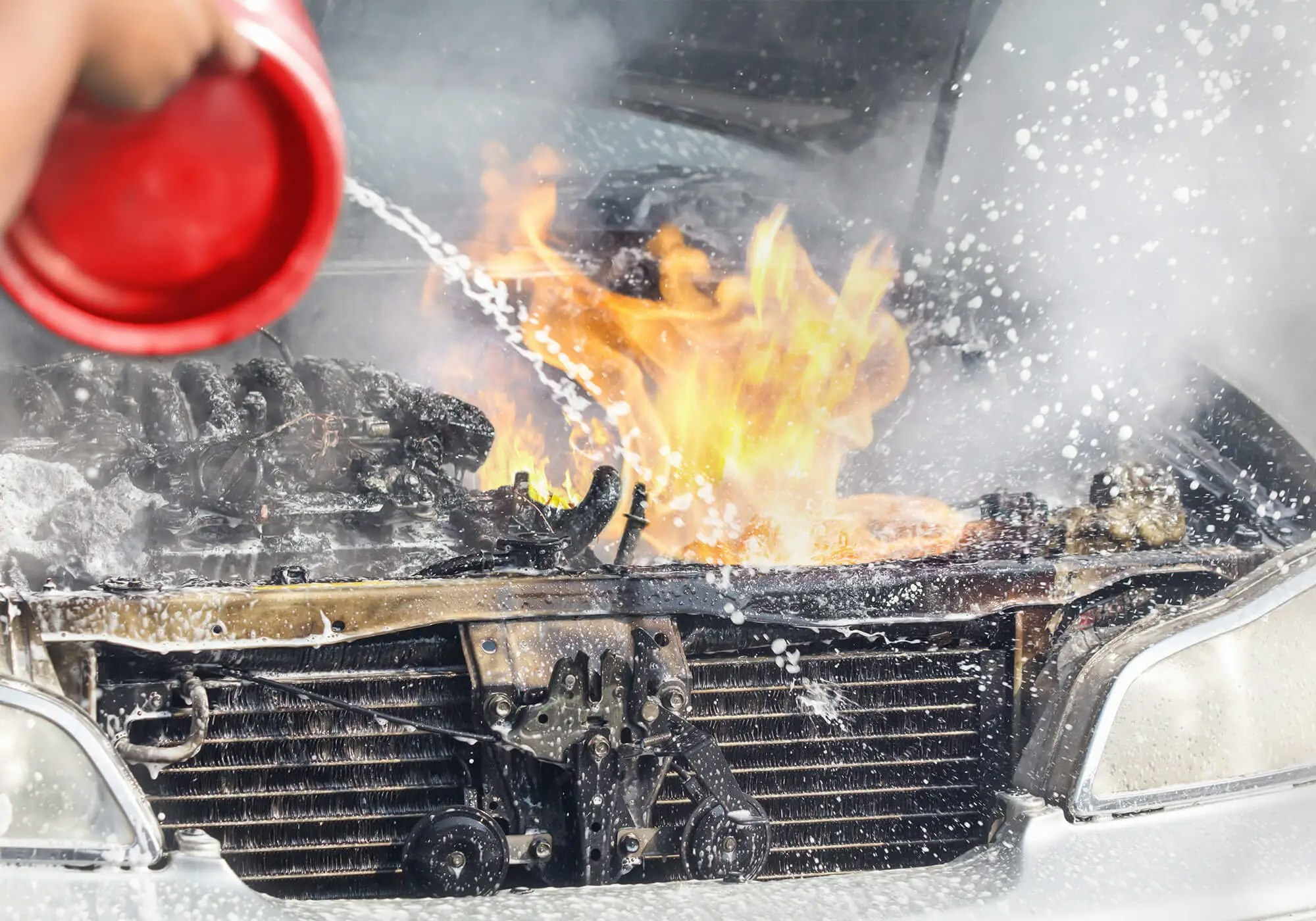EV Battery Fires Challenge Fire Departments

August 11, 2021 | Alex Terlecky
As EVs increase in popularity, fire departments have a new challenge to face.
After decades of research and development, Electric vehicles, or EVs, are finally catching on with the public due to the popularity of Tesla, the imminence of our climate crisis, and a drop in prices for manufacturing lithium-ion batteries.
With many automakers, such as Ford, GM, and Volkswagen, recently throwing their hat into the ring, the National Transportation Safety Board (NTSB) has asked automakers to improve electric vehicle emergency response guides in order to better address fires that result from the batteries.
In a January Press release, NTSB issued their safety recommendations based on their recent findings from an investigation of four electric vehicle fires involving the high-voltage, lithium-ion batteries. In three of the four instances, after fire crews extinguished the blast, the batteries reignited.
In a more recent incident, not reviewed by the NTSB, in Houston in April 2021, two people were killed when a Tesla crashed into a tree and ignited into flames. According to local news sources, the fire took firefighters four hours to extinguish and more than 30,000 gallons of water.
Even with increased incidents and awareness from NTSB, recent findings have shown that 31% of fire departments surveyed don’t train for EV fires, and half of those surveyed reported they have no special protocols in place to deal with EVs following a crash.
What are the Risks?
According to NTSB’s press release, fires in EVs powered by these high-voltage, lithium-ion batteries carry the risk of electric shock to first responders from exposure to the high-voltage components of a damaged battery. First responders must also deal with fire suppression and the potential of thermal runaway—when damaged cells within the battery experience uncontrolled increases in temperature and pressure leading to the reignition.
Shock
To protect against shock, current vehicle standards require isolating the EV’s high-voltage battery from the chassis during vehicle assembly. The manufacturer is also required to include specific marking for high-voltage systems and orange coverings to identify high-voltage cables. Manufacturers also ensure the high-voltage system can be isolated by disconnecting the high-voltage circuits between the lithium-ion battery and the powertrain. Emergency response guides, which can be found online, are available for 36 different models of EV equipped with lithium-ion batteries, and all provide instructions for high-voltage disconnect.
It’s important to note, however, that although disconnects will isolate the battery, they will not remove the energy from the battery itself. NTSB notes that crash damage and fires may prevent access to the disconnects in EVs, but that when accessible, the manufacturers’ emergency response guides are sufficient in providing information to remove the connection.
Fire Suppression
When managing a crashed EV, high-voltage components are one thing; the fire is another. Extinguishing a high-voltage battery fire is a monumental task in itself, often requiring an average of 2,600 gallons of water, depending on the size and location of the battery.
In four NTSB investigations, water used to suppress EV fires ranged from 300 gallons in one incident in Fort Lauderdale to 20,000 in a Lake Forest incident. In this latter case, first responders could not extinguish the fire until raising the vehicle and applying water directly to the battery on the vehicle’s underside.
NTSB reviewed emergency response guides for fire suppression and found that most manufacturers were lacking necessary, vehicle-specific details on fire suppression.
Thermal Runaway and Battery Reignition
The process of thermal runaway begins with overheating in individual battery cells which degrades their electrical isolation, according to the NTSB. This can happen without the presence of flames.
For emergency responders, it is best to use your senses when responding to an EV. Listen for sounds coming from the battery that might indicate something is wrong, such as gurgling, crackling, hissing, or popping, indicating overheating or system arching, or smells such as a burnt odor, indicating fire or heat damage.
Even after an EV battery fire has been extinguished, it could still reignite. It is recommended that emergency responders use thermal imaging to monitor the battery. Another best practice is to continue applying water to adequately cool the battery, even after no flames are visible, to reduce the risk of reigniting. This process could take an hour or more, according to the NTSB.
Response Guidance
According to FEMA, when responding to an EV crash, first responders should break down the encounter into three categories—pre-attack, attack, and post-attack—to mitigate risk.
Pre-attack
- Park uphill and upwind
- Establish an appropriate incident command structure
- Identify the type of vehicle involved
- Use a thermal imaging camera
- Establish tactical priorities
- Consider the incident could be a combined fire, extrication, and hazmat incident
Attack
- Wear full PPE and a self-contained breathing apparatus
- Secure a large, continuous supply of water
- Treat all conductive surfaces as if they are energized until proven safe
- Stabilize the vehicle
- Power down, if possible
Post-attack
- Have enough personnel and apparatus on scene for extended operations to monitor battery heat and reignition
- Brief wrecker or towing company, if turning vehicle over to third party
- Follow wrecker or towing company to storage area, and place EV in a space over 50 feet away from other vehicles, buildings, or combustibles
For additional resources, the National Fire Protection Association has made an emergency field guide available and dedicated a portion of their website entirely to EVs.
A New Tool
Firefighters and first responders are already familiar with the use of “hot sticks”, a probe which detects the presence of AC voltage in a wire or conductive material.
However, typical AC hot sticks do not work for DC voltage, due to differences in the physics involved. On top of that the DC detectors that exist today are often large and unreliable, and not optimal for field use.
To deal with this issue, the United States Fire Administration is working to develop a new DC hot stick to keep first responders safe from electrical exposures that would slip onto the end of an AC probe. The prototype, which has been licensed with product testing underway, detects DC voltage and also ensures the probe is property tapped and in contact with the electrical lines to prevent false negatives.
While not on the market yet, we will update this article with information once testing is complete. FEMA expects the product will “be announced to the market soon.”
Safety Grant Reimbursement
With over one million electric and plug-in cars driving in the US, fire departments and first responders need to be prepared for dealing with a lithium-ion battery fire. As always, having a plan is important to mitigate risks and threats to drivers, passengers, and the response team.
Remember, if you are a CSD Pool member and make a purchase related to safety and loss prevention, including purchases to help mitigate risk of EV battery fires, you may qualify for up to 50% reimbursement of that item through our Safety and Loss Prevention Grant Fund. Learn more at csdpool.org/safety-grants.

